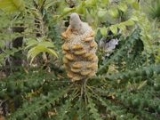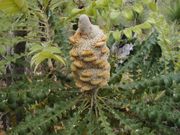
Banksia grandis
Encyclopedia
Banksia grandis, commonly known as Bull Banksia, Giant Banksia or Mangite, is a common and distinctive tree in South West Western Australia
.
Bull Banksia usually grows as a tree
between 5 and 10 metres high, but may attain heights of up to 15 metres. It is also found in the form of a stunted, spreading shrub, near the south coast and whenever it occurs among granite rocks. Its trunks are short, stout and often crooked, with the rough grey bark characteristic of Banksia. The leaves are very distinctive; they are very large, being up to 45 cm long and 11 centimetres wide, and consist of a series of triangular lobes that go right back to the prominent midrib. Shiny dark green on top, they have a soft white tomentum
underneath. New growth is a paler lime green and very attractive. Flowering is in Summer. The large cylindrical flower spikes, which can reach up to 35 cm high, are yellow, with a cream style. The "cones" shed their old flower parts early, so do not have the hairy appearance of the "cones" of many other Banksia species. Old cones are often varnished or cut and the typical banksia
species used in decorative woodwork.
 Bull Banksia is common throughout south west Western Australia, occurring from Jurien (30°17′S) in the north, south to Cape Leeuwin
Bull Banksia is common throughout south west Western Australia, occurring from Jurien (30°17′S) in the north, south to Cape Leeuwin
(34°22′S) and east to Bremer Bay
(34°23′S 119°22′S E). It has been found inland as far as Badgedup and Dongolocking Nature Reserve. It is very common on the lateritic
soils of the Darling Range, where it forms an understory in Jarrah and Marri
forests. It will grow on nearly all soils of the coastal sandplain, but is somewhat less common there.
Banksia grandis is a member of Banksia ser. Grandes, a series containing only B. grandis and the closely related species B. solandri
. No subspecific taxa are recognised, as it shows little variation except that it grows as a spreading shrub near the south coast. A seed from the south coast raised in Kings Park
has retained its spreading habit.
The flowers of Banksia grandis were known as mangyt, pulgarla or Bool gal la by the Indigenous peoples who live within its range. The flowers were steeped in water or sucked to obtain nectar
and is difficult to grow in regions of summer humidity. It requires a well drained sandy soil. Seeds do not require any treatment, and take 22 to 42 days to germinate.
Western Australia
Western Australia is a state of Australia, occupying the entire western third of the Australian continent. It is bounded by the Indian Ocean to the north and west, the Great Australian Bight and Indian Ocean to the south, the Northern Territory to the north-east and South Australia to the south-east...
.
Bull Banksia usually grows as a tree
Tree
A tree is a perennial woody plant. It is most often defined as a woody plant that has many secondary branches supported clear of the ground on a single main stem or trunk with clear apical dominance. A minimum height specification at maturity is cited by some authors, varying from 3 m to...
between 5 and 10 metres high, but may attain heights of up to 15 metres. It is also found in the form of a stunted, spreading shrub, near the south coast and whenever it occurs among granite rocks. Its trunks are short, stout and often crooked, with the rough grey bark characteristic of Banksia. The leaves are very distinctive; they are very large, being up to 45 cm long and 11 centimetres wide, and consist of a series of triangular lobes that go right back to the prominent midrib. Shiny dark green on top, they have a soft white tomentum
Tomentum
Tomentum may refer to the following:*In botany, a covering of closely matted or fine hairs on plant leaves. *A network of minute blood vessels in the brain.* Tomentum in zoology are a short, soft pubescence...
underneath. New growth is a paler lime green and very attractive. Flowering is in Summer. The large cylindrical flower spikes, which can reach up to 35 cm high, are yellow, with a cream style. The "cones" shed their old flower parts early, so do not have the hairy appearance of the "cones" of many other Banksia species. Old cones are often varnished or cut and the typical banksia
Banksia
Banksia is a genus of around 170 species in the plant family Proteaceae. These Australian wildflowers and popular garden plants are easily recognised by their characteristic flower spikes and fruiting "cones" and heads. When it comes to size, banksias range from prostrate woody shrubs to trees up...
species used in decorative woodwork.

Cape Leeuwin
Cape Leeuwin is the most south-westerly mainland point of the Australian Continent, in the state of Western Australia.A few small islands and rocks, the St Alouarn Islands, extend further to the south. The nearest settlement, north of the cape, is Augusta. South-east of Cape Leeuwin, the coast...
(34°22′S) and east to Bremer Bay
Bremer Bay, Western Australia
Bremer Bay is a coastal town situated on the south coast of Western Australia in the Great Southern region between Albany and Esperance, at the mouth of the Bremer River. Bremer Bay is southeast of the state capital, Perth, and east of Albany. The town has a population of about 240...
(34°23′S 119°22′S E). It has been found inland as far as Badgedup and Dongolocking Nature Reserve. It is very common on the lateritic
Laterite
Laterites are soil types rich in iron and aluminium, formed in hot and wet tropical areas. Nearly all laterites are rusty-red because of iron oxides. They develop by intensive and long-lasting weathering of the underlying parent rock...
soils of the Darling Range, where it forms an understory in Jarrah and Marri
Corymbia calophylla
Corymbia calophylla is a bloodwood native to Western Australia. Common names include Marri and Port Gregory Gum, and a long standing usage has been Red Gum due to the red gum effusions often found on trunks.It is distinctive among bloodwoods for its very large buds and fruit Corymbia calophylla...
forests. It will grow on nearly all soils of the coastal sandplain, but is somewhat less common there.
Banksia grandis is a member of Banksia ser. Grandes, a series containing only B. grandis and the closely related species B. solandri
Banksia solandri
Banksia solandri, commonly known as Stirling Range Banksia, is a species of large shrub in the plant genus Banksia. It occurs only within the Stirling Range in southwest Western Australia.-Description:...
. No subspecific taxa are recognised, as it shows little variation except that it grows as a spreading shrub near the south coast. A seed from the south coast raised in Kings Park
Kings Park, Western Australia
Kings Park is a park located on the western edge of Perth, Western Australia central business district. The park is a mixture of grassed parkland, botanical gardens and natural bushland on Mount Eliza with two thirds of the grounds conserved as native bushland. With panoramic views of the Swan...
has retained its spreading habit.
The flowers of Banksia grandis were known as mangyt, pulgarla or Bool gal la by the Indigenous peoples who live within its range. The flowers were steeped in water or sucked to obtain nectar
Ecology
Species of nectarivorous birds that have been observed feeding on B. grandis include Anthochaera carunculata (Red Wattlebird). Purpureicephalus spurius (Red-capped Parrot) has also been recorded feeding upon the seed, as have Black Cockatoos, though it is not clear which species of black cockatoo was observed, Calyptorhynchus baudinii (Baudin's Black Cockatoo) or C. latirostris (Carnaby's Black Cockatoo).Cultivation
Bull Banksia is very sensitive to diebackPhytophthora cinnamomi
Phytophthora cinnamomi is a soil-borne water mould that produces an infection which causes a condition in plants called root rot or dieback. The plant pathogen is one of the world's most invasive species and is present in over 70 countries from around the world.- Life cycle and effects on plants :P...
and is difficult to grow in regions of summer humidity. It requires a well drained sandy soil. Seeds do not require any treatment, and take 22 to 42 days to germinate.

